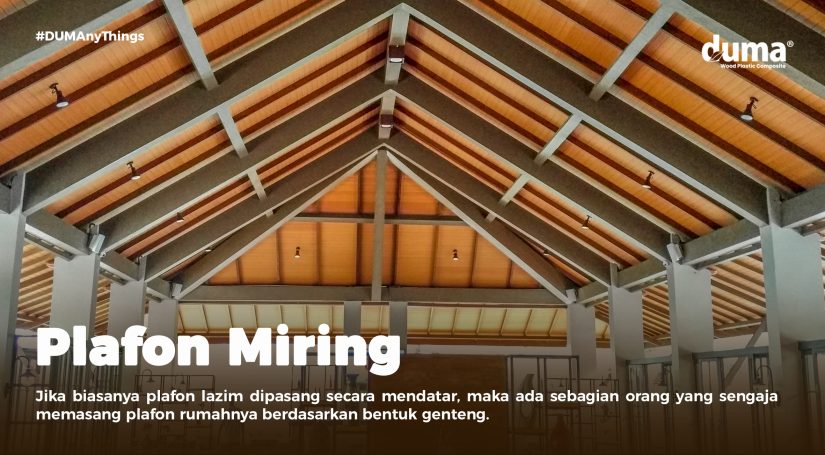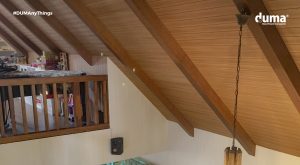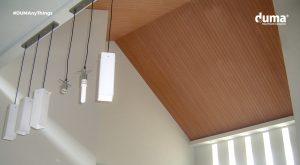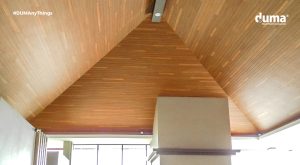
In the world of interior design, the ceiling is not merely a cover for the roof structure—it is a key visual element that greatly influences the character of a room. One trend that is growing in popularity is the use of sloped ceilings that follow the pitch of the roof. This design offers not only a unique aesthetic but also a range of functional benefits that make it worth considering.
Advantages of Sloped Ceilings
- Creates a Sense of Spaciousness
Sloped ceilings give the illusion of height, making rooms—especially living areas—feel more open, airy, and expansive. - Enhances Air Circulation and Natural Lighting
With varying heights, sloped ceilings allow for better air circulation. When paired with tall windows or skylights, they also maximize natural light penetration. - Adds a Dynamic and Artistic Design Element
Sloped ceilings can highlight the architectural character of a home, particularly in Scandinavian, modern tropical, or industrial-style houses. The angled lines bring a distinctive visual contrast compared to traditional flat ceilings. - Follows the Building’s Original Structure
In many home designs, a pitched roof is an integral structural feature. By aligning the ceiling with the roof’s shape, the design becomes more structurally efficient and avoids wasting space.
Advantages of Sloped Ceilings
- Creates the Illusion of a Larger Space
A sloped ceiling gives the impression of greater height, making a room—especially a living room or family room—feel more spacious, open, and airy. - Improves Air Circulation and Natural Lighting
With varying ceiling heights, sloped ceilings allow for better airflow. When combined with tall windows or skylights, they also enhance the entry of natural light into the space. - Adds a More Dynamic and Artistic Design
Sloped ceilings emphasize the architectural character of a home, especially in Scandinavian, modern tropical, or industrial-style houses. The angled lines offer a unique and visually appealing alternative to conventional flat ceilings. - Follows the Building’s Original Structure
In some home designs, a pitched roof is a fundamental part of the structure. Aligning the ceiling with the roof shape makes it more structurally efficient and ensures no space is wasted.
Challenges in Applying Sloped Ceilings
- Installation Complexity
Installing a sloped ceiling requires high precision. Incorrect angles can affect both the appearance and structural integrity of the ceiling. - Lighting and Ventilation Planning
The placement of pendant lights, air conditioners, or ceiling fans must be carefully calculated to suit the ceiling’s slope. - Material Selection
Ceiling materials must be lightweight yet durable enough to adapt to the angle, such as gypsum board, plywood, or high-quality PVC. - Higher Cost
Due to the more complex planning and installation process compared to flat ceilings, sloped ceilings generally come with a higher installation cost.
Tips for Designing the Ideal Sloped Ceiling
- Use Layered Lighting
Combine spotlights, pendant lights, and wall sconces to achieve balanced and functional lighting throughout the space. - Incorporate Natural Materials
Add wooden accents to bring warmth and a natural feel to rooms with high ceilings. - Establish a Focal Point
A sloped ceiling can be designed to draw attention to a specific area of the room, such as a seating space or fireplace.
#DUMAnyThingsWithDUMA #duma #wpc #woodplasticcomposite #dumawpc #plafon #plafonwpc #plafonkayu #plafonantirayap #arsitekjakarta #arsiteksurabaya #interiorjakarta #interiorsurabaya #kontraktorjakarta #kontraktorsurabaya #antirayap #pintu #dindingwpc #pintuwpc #lantai #lantaiwpc #tahanair #pelapisdinding #archnesia #interiorindonesia #architecturelovers #arsitekinterior #arsitekindonesia


